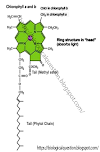Watson and Crick's Model of DNA
Working of Scientists on DNA Structure :
Erwin Chargaff :
In 1951, Erwin Chargaff found that the nitrogenous bases in a DNA show specific ratios. He observed that
amount of adenine is always equal to the amount of thymine and amount of guanine is always equal to
the amount of cytosine in DNA. This implies that the total purines and total pyrimidines are in 1:1 in any
DNA. This conclusion is known as Chargaff's rule.
Maurice Wilkins and Rosalind Franklin :
In those days the X-ray diffraction analysis of DNA by
Maurice Wilkins and Rosalind Franklin was published. They first time claimed that DNA is a duplex
(double helix) molecule. The width of duplex is 2nm while the length of each turn is 3.4nm.
James Watson and Francis Crick :
In 1953, on
the basis of these observations a graduate student Francis Crick and a research fellow James Watson of
Cambridge University proposed a physical model of DNA which is now called Watson and Crick Model of
DNA.
Double Helical Structure of DNA Proposed By Watson and Crick's Model of DNA .
According to this model a DNA is made up of two polynucleotide chains which are attached together by
base pairs. In order to make base pairing the two polynucleotide chains are opposite in direction i.e., one
chain runs from 5' to 3' downward and the other chain runs from 5' to 3' upward. Both chains show a
constant width of 2 nm. Therefore, both chains are supposed be antiparallel to each other. The base
pairing is very specific i.e., Adenine makes the pair with Thymine and Guanine with Cytosine. The base
pairs are held together by the hydrogen bond. There are three hydrogen bonds between Guanine and
Cytosine and two hydrogen bonds between Adenine and Thymine. Each turn of the duplex consist of 10
base pairs. Both polynucleotide chains are complementary to each other. There is no restriction of the
sequence of nucleotides along the length of a DNA strand. The sequence can vary in countless ways. The
sequence is specific for different species, organisms and even individuals.
Watson and Crick's model was groundbreaking and earned them the Nobel Prize in Physiology or Medicine in 1962. It provided a basis for understanding the mechanisms of DNA replication, transcription, and translation, and for exploring the genetic basis of inheritance, disease, and evolution.
Thank you for Reading the article.



.png)

.png)
0 Comments